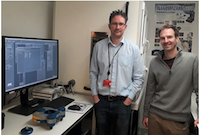Members Login

Channels
Special Offers & Promotions
JPK Reports on Research by Professor Guillaume Charras and his Team to Understand the Fundamental Mechanical Properties of Cells & Tissues at the London Centre for Nanotechnology
 JPK Instruments, a world-leading manufacturer of nanoanalytic instrumentation for research in life sciences and soft matter, reports on the research of Professor Guillaume Charras of the London Centre for Nanotechnology where he is applying AFM to understand the fundamental mechanical properties of cells and tissues.
JPK Instruments, a world-leading manufacturer of nanoanalytic instrumentation for research in life sciences and soft matter, reports on the research of Professor Guillaume Charras of the London Centre for Nanotechnology where he is applying AFM to understand the fundamental mechanical properties of cells and tissues.
Professor Guillaume Charras leads a research group at the London Centre for Nanotechnology. Their overall goal is to understand fundamental mechanical properties of cells and tissues. They are particularly interested in the interplay between signalling and cell mechanics and how mechanical changes govern cellular and embryonic morphogenesis.
The group have used AFM from JPK Instruments for over a decade. Indeed, AFM offers a quantitative method for estimating mechanical properties. While originally restricted cellular mechanics, the expanded z-range of JPK's CellHesion® 200 allows studies on cultured and embryonic tissues. The recent purchase of a NanoWizard® 4 BioScience AFM system will allow the group to image changes in the organization of the submembranous actin cortex (the main determinant of cell shape) as the cell undergoes mitosis. This will complement other microscopies such as scanning electron microscopy for the cortex organization at the scale of single actin filaments, confocal microscopy for imaging localization of proteins during morphogenesis at high frame rate, and optogenetics to manipulate cell signalling.
When asked about why he particularly likes using the instrumentation from JPK, Professor Charras said, “I find their systems reliable and very user-friendly. The large z range is vital to our work and the possibility to combine this with multi-position imaging allows us to extract the maximum amount of data from each experiment. We have illustrated this in a paper when we used the CellHesion® 200. This has an extra long z piezo range of 100 µm that enabled us to collect force-indentation data over a large indentation range while ensuring there was separation of the tip from the sample during retraction1. Furthermore, the long z-range has now made it possible to monitor changes in mechanical properties in living frog embryos2. With the arrival of our latest NanoWizard® AFM, we are optimistic of more ground-breaking publications in the coming months.”
Media Partners


